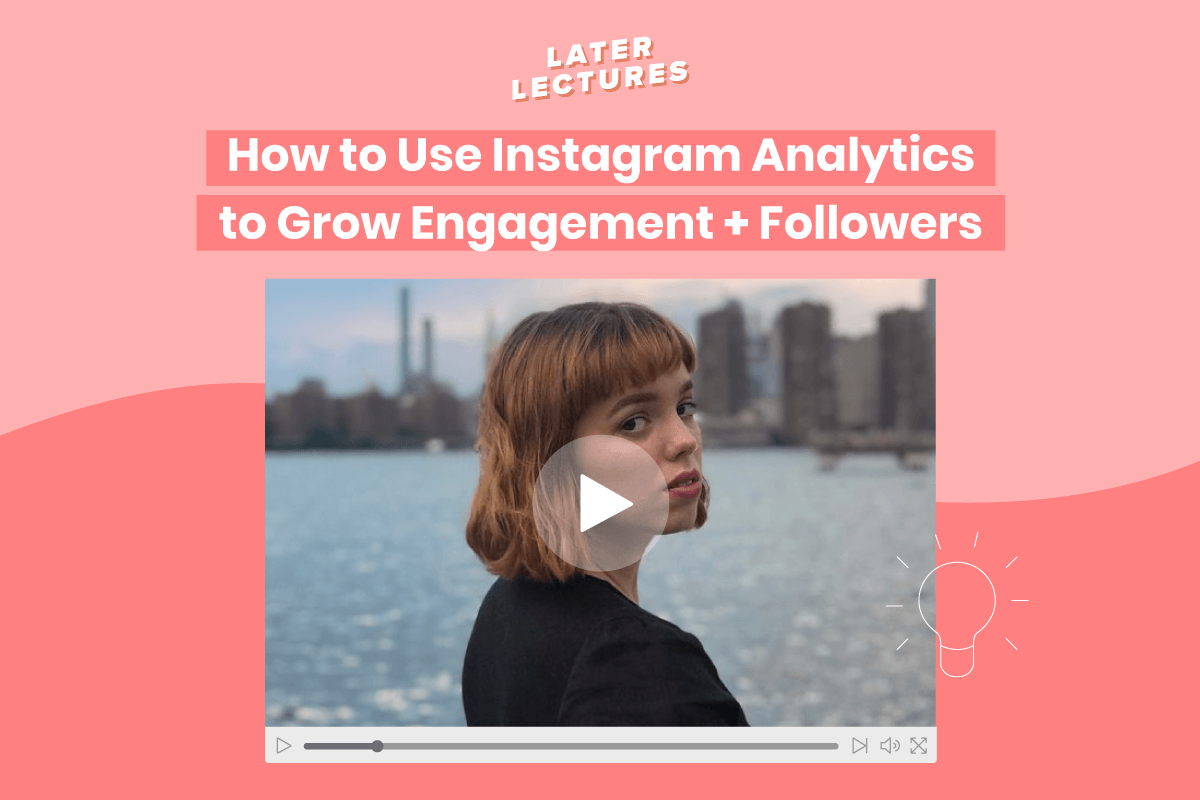If you want to get more engagement and followers, it all starts with understanding Instagram analytics.
The data from your Instagram analytics should inspire your content strategy, and not the other way around.
Once you’re comfortable understanding Instagram analytics, you’ll be able to adjust your strategy to create content that your followers will engage with, and create a profile that will attract your target market.
Why Understanding Instagram Analytics is So Important for Your Account’s Growth
Understanding Instagram analytics and translating the jargon into useful takeaways can be overwhelming. But we promise that anyone can do it!
Forget the complicated formulas and technical terminology.
What you really need to focus on with your Instagram analytics are the things you can change, adapt, and adopt to boost your engagement and growth.
Understanding Instagram analytics and what the data means for your account not only supports the work your already doing, but it can also spark new ideas for your strategy and improve all the work you’ve already begun.
So it’s a win-win situation!
Instagram analytics go beyond which posts get the most likes or comments. They look at the much broader picture of your account’s overall health and can help you analyze your audience’s demographics, behaviors, and patterns.
It’s the best way to make informed decisions and adjustments to your content strategy.
Accessing Your Instagram Analytics with an Instagram for Business Account
If you want to access all that info and tap into Instagram’s goldmine of analytics, you’re going to need to switch to a business account.

There are other perks to making the switch to an Instagram business profile too, like the ability to add links in Instagram Stories, creating Instagram ads, and building out your bio with email and contact details.
If you haven’t set up an Instagram business profile yet, don’t worry! It only takes a couple of minutes — just follow the steps in this blog post!
Already have an Instagram business profile? Tap on the bar chart icon on the top of your profile page to access your native Instagram analytics.

Understanding Instagram Analytics: The Audience Tab
Before we look at your content’s performance on Instagram, we need to learn more about your audience.
By understanding the Instagram analytics for your specific audience, you’ll know important details like when your audience is online, where they live, how old they are, and what actions they take on your page.
This means you’ll be able to tailor your strategy and fine-tune any content you post in the future.
Let’s start with analyzing your audience demographics under the Audience tab:
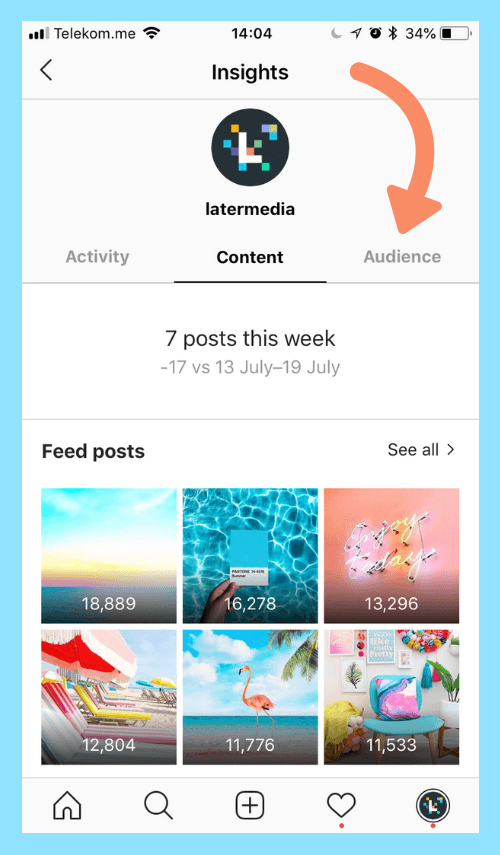
Track Your Instagram Follower Growth
The first thing you’ll want to monitor and track is your follower growth.
If your goal is to grow your account, you definitely want to take a look at how many followers you are getting each week.
Track your follower count over time in an Excel spreadsheet, and review how quickly you’re growing each month.
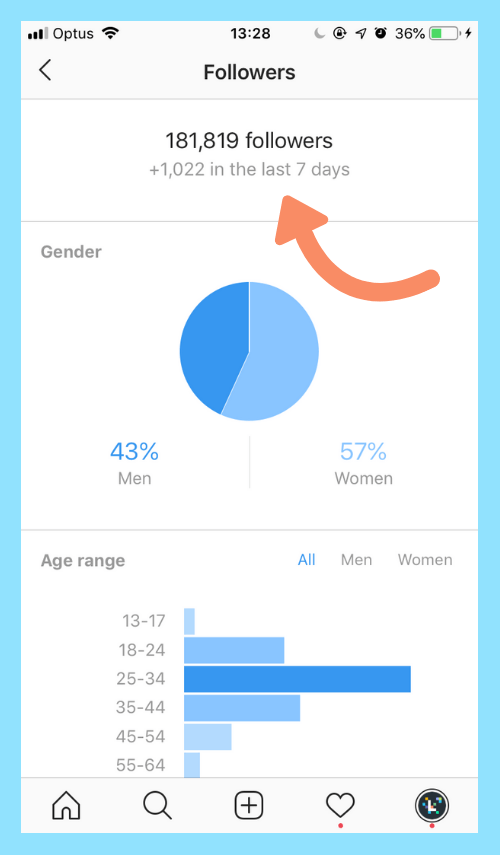
It’s also a good idea to monitor any spikes or jumps in your follower count to see if it’s related to the content you’ve posted or changes to your Instagram strategy.
See Where Your Instagram Followers Are Located
While you might have a strong idea of where your audience is based, Instagram Insights really helps you hone in on their locations, right down to what percentage of your followers are in different cities in the world!

This can be particularly useful if you’re posting across different time-zones to pick the right time to post. Or if you notice that a sizeable part of your audience lives in non-English countries, you might consider adjusting your content strategy to be less copy-heavy for broader understanding.
Another useful tip when working with influencers or collaborating with a brand is to see where the majority of their audience is based.
If there’s a strong overlap of audience locations, you stand a good chance of owning the space, or it may be a good opportunity to reach new audiences in a completely new marketplace!
Find out Your Instagram Followers’ Gender and Age
Keeping an eye on your followers’ gender and age metrics can help you make sure that you’re reaching the right audience for your business on Instagram — but it can also help you tailor the kind of content you post and when you post it.

For example, if you have a younger target audience and demographic, you could try posting more often or sharing memes or animated GIFs.
If your audience is older, you may want to focus on content that resonates with them specifically.
This is also where you should check to make sure that the target audience for your business is matching up with the people you’re attracting on Instagram.
If you notice that your social audience skews more older or younger than your target demographic, you’ll want to adjust the type of content that you’re posting.
Find out When Your Followers Are Most Active
If you’re feeling lost about what time to post, checking out when your audience is most active on Instagram is really important.

For example, if you can see an uptick for engagement on weekend mornings, you could consider posting more frequently during that time, and less during the work week to suit your audience’s behaviors.
Similarly, if you’re noticing a spike at a certain time each day, you’ll want to make sure you’re posting within that window.
But if you want to completely take the guesswork out of knowing when to post, try Later’s Best Time To Post feature.
The Later algorithm determines your best time to post by analyzing your historical post data on your top performing posts and then highlights the times right on your content calendar — all you have to do is choose what to post!
Understanding Instagram Analytics: The Activity Tab
Now that you know more about your Instagram audience, it’s time to take a look at how they are engaging with your account.
Under the Activity tab, you’ll find metrics to see how your audience is engaging with your account under Interactions.
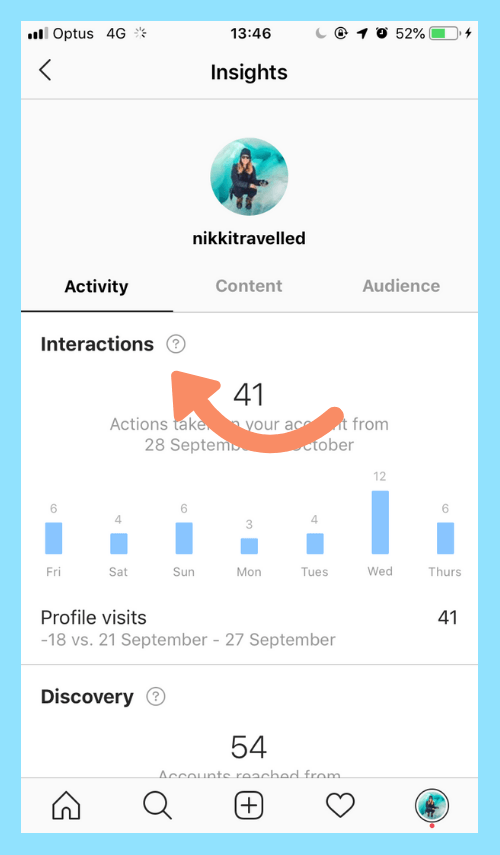
This is a useful metric to track, especially if you’re trying something new in your strategy, or making a big announcement via Instagram.
For example, if you posted about the launch of your new online shop on Thursday, you’d hope to see a larger number of interactions on that day to indicate people went to your bio and clicked the link.
Your Interactions metrics are indicators of what is and isn’t working in your strategy, and you might want to make adjustments based on them.
Find Out How Your Audience Is Discovering Your Instagram Profile
Now we’re getting into the more complicated Instagram analytics terms: Reach and Impressions.
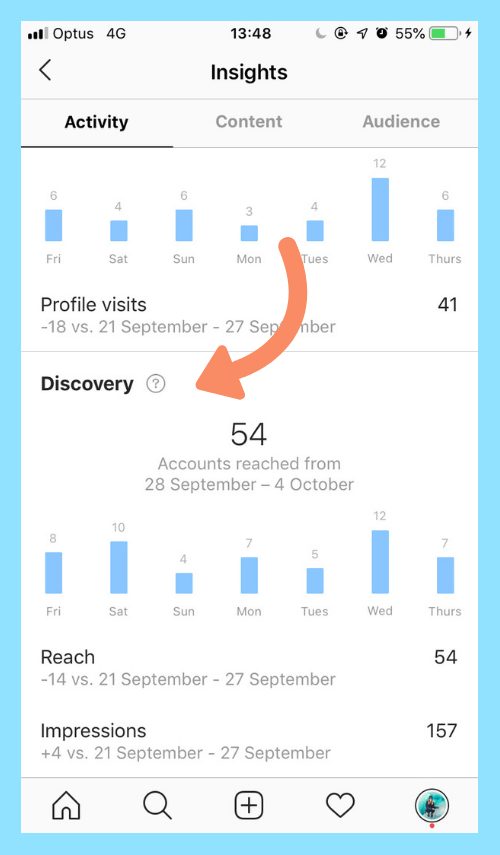
Impressions: This is the total number of times your post has been seen. This number includes users scrolling by in their feed, clicking-through to your business’ profile to view a photo, or viewing content directly through an Instagram Direct Message.
Reach: Like Impressions, Reach also relates to the number of views your posts get. But rather than calculate it by total eyes on your content, it narrows it down to unique views only.
So if you’re tracking your account’s Reach over time, it will help you determine if the new followers you’re gaining are actually seeing your content.
Understanding Instagram Analytics: The Content Tab
Now that you understand how your Instagram audience is interacting with your content, it’s time to dive in to content performance to find out what types of content your followers are engaging with most.
The data you’ll find here is important if you want to increase engagement on your posts.
Start by tapping on the Content tab from your Instagram Insights. And from here, select See All under the tabs section.
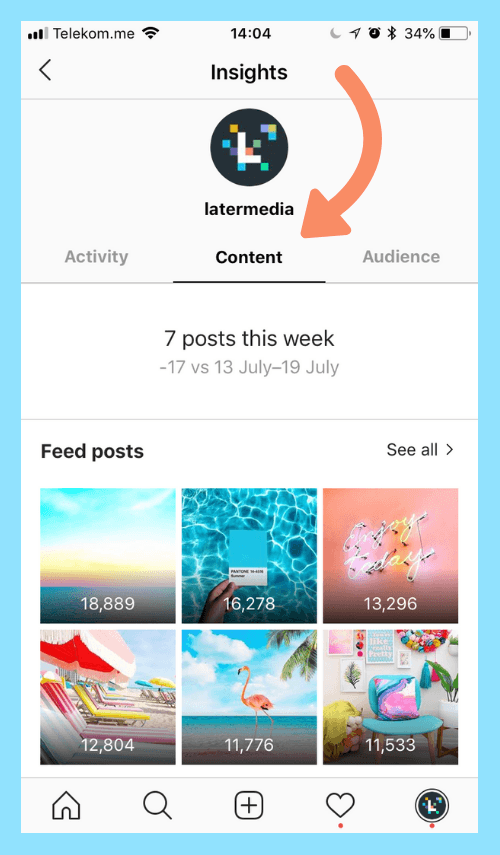
Now you’ll be able to filter and break down your content by type (photo, video, shopping, carousel) and by Instagram metrics, like clicks, comments, engagement rate, impressions, and reach.
There are so many to filter variations to choose from — you’ll really be able to focus in on your content’s performance in this section!
One thing to keep in mind when reviewing your content is its Engagement. This is the total number of unique accounts that have liked, commented, and saved a particular photo or video.
By sorting posts by engagement, you can see what content types are resonating best with your audience. Maybe you’ll notice that quotes do really well on page, so you’ll want to post more of those.
Similarly, you can look at your posts that are performing the worst, and see if you notice any patterns there. Maybe they’re all the same color scheme, or were posted on a weekend vs a weekday?
By sorting through your content by engagement rate, you’ll be able to notice patterns and understand what content types you should create more of, and which ones you should stop posting or improve upon.
One great way to measure your growth on Instagram is by monitoring your Engagement Rate.
Engagement Rate is the percentage of followers or viewers that engage with your posts. Generally, if you want to calculate your average engagement rate for Instagram, you would divide the total number of likes and comments by your follower count, which will give you a percentage. To make it easy: Engagement Rate = (likes + comments) / followers x 100.

To make it super-easy to track your engagement rate, check out Later’s Pro Analytics!
The huge bonus with the Pro Analytics – which is available with any Later paid plan — is that your Engagement Rate is calculated for you, so there’s no need to do any math!
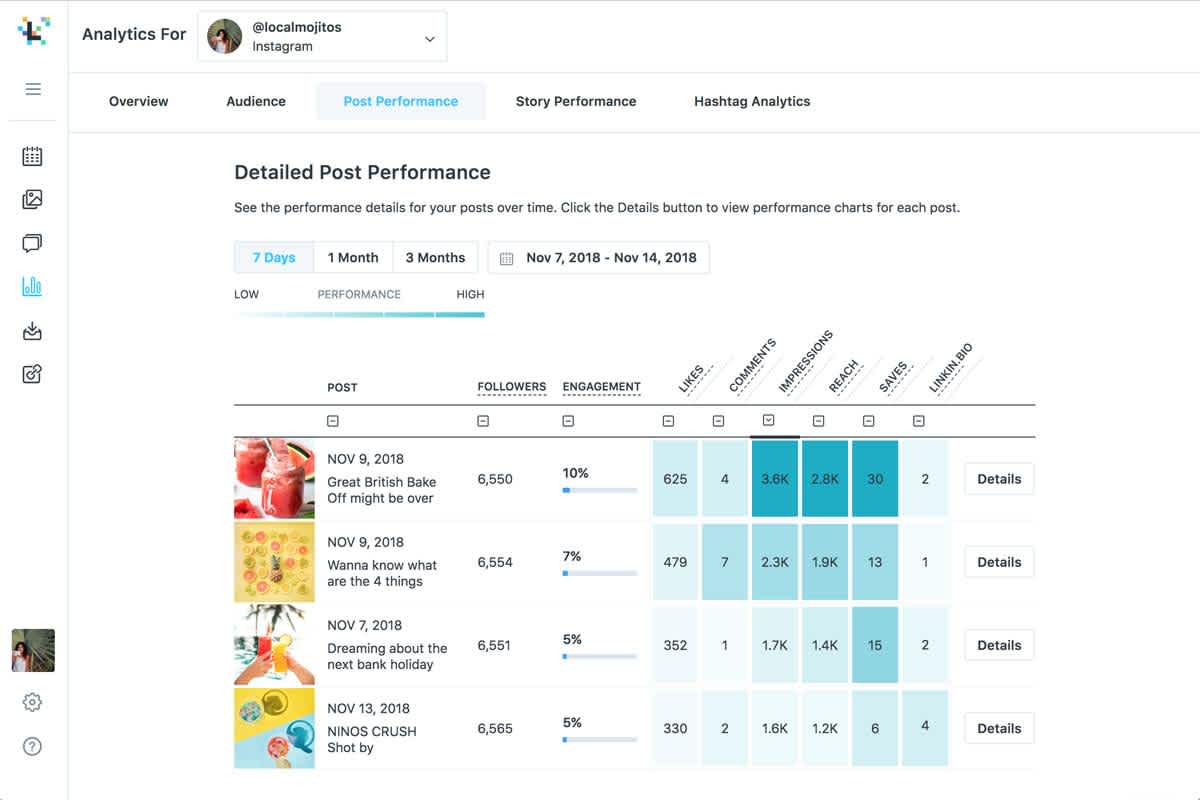
But a “good” engagement rate will be different for every account, and it’s more important to monitor the growth, and progress towards your overall Instagram goals!
Setting Goals And Measuring Your Instagram Account’s Sucess
How we measure success or failure of an Instagram post, or overall account, will completely depend on your business goals!
What’s important is truly understanding the Instagram analytics for your account and choosing goals or key performance indicators (KPIs) that will help you find out if our content is doing well or not.
If your business thrives on community, you may want to look to engagements as your KPI for your photo and video posts to see how much they resonate and trigger conversations on your posts.
Or if your overall goal is to grow this quarter, you could look at your Reach metrics to see how many unique eyes see your content.
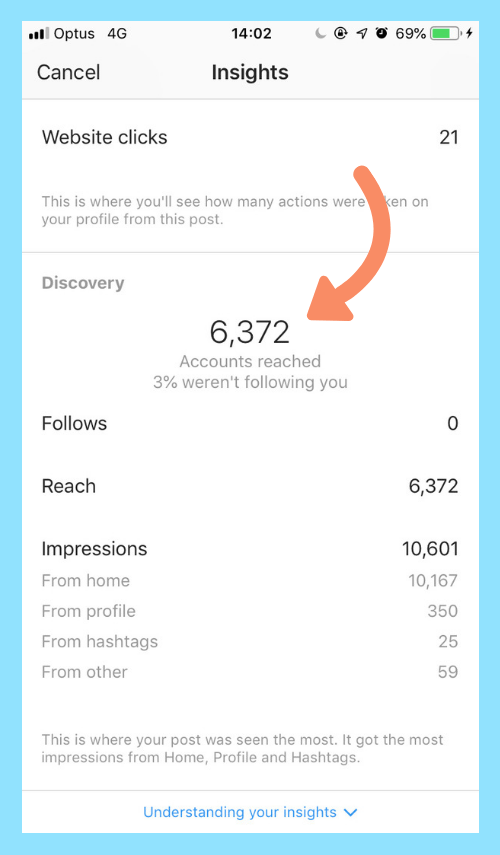
One thing to remember is that different types of content might need different KPIs. For example, while both photos and videos appear within a user’s individual feed, the way a user interacts with each type of content is vastly different, and this directly affects performance.
So for videos, you might want to track views, but for photos, engagement could tell you a lot more about how your content is performing.
Whatever metrics you choose to track, the most important thing is to have a constant benchmark to measure your growth against.
Without a benchmark, you have no solid starting point to highlight your growth or pinpoint at what stages in your strategy you saw improvement.
Using Instagram Analytics to Improve Your Content and Grow Your Account
You’ve set benchmarks and goals for our account, and you’ve worked hard to understand the Instagram analytics behind your content.
Now it’s time to use those metrics to identify any opportunities to change up or improve your strategy!
Here are some tips to keep in mind when thinking about changing your strategy:
Don’t have a knee-jerk reaction to your Instagram analytics. Overall, keep your eyes on patterns and learnings across all your content and don’t make any sudden overhauls of your strategy based on a one-off post!
Review your top and bottom performing posts. What can you learn from the type of content that performed the best, compared to those that flopped? It’s important to look at both, not just your stellar posts month after month.
A/B test to improve your content: Try to track trends over time or A/B test particular sets of hashtags, or types of content, to see what improves your numbers.
Regardless of whether you’re just starting out and getting to grips with understanding Instagram analytics, the important thing to remember is that your account is always in flux.
You should regularly be checking in with your Instagram analytics to see where there are opportunities for growth, and celebrating the content and actions that have been a success for your account!
If you’re looking to really level-up your understanding of Instagram analytics, check out our free Instagram Analytics Strategy guide! It’s 65 pages of hands-on info on how to start tracking your account’s performance and make better decisions about your strategy.
